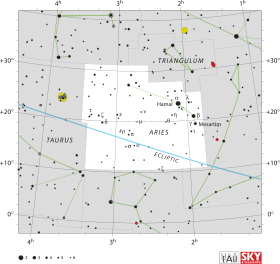|
Astrométrie
| Vitesse radiale |
+9,5 ± 0,1 km/s[5] |
| Mouvement propre |
μα = +233,122 mas/a[1]
μδ = −168,438 mas/a[1] |
| Parallaxe |
47,155 1 ± 0,060 3 mas[1] |
| Distance |
69,17 ± 0,09 al
(21,21 ± 0,03 pc) |
| Magnitude absolue |
4,85 ± 0,07[2] |
Désignations
modifier 
51 Arietis est une étoile de la constellation du Bélier. 51 Arietis est sa désignation de Flamsteed. C'est une étoile jaune pâle, difficile à observer à l'œil nu, avec une magnitude apparente de 6,6[2]. Sur la base des mesures de la parallaxe, elle est située à ∼ 69,2 a.l. (∼ 21,2 pc) de la Terre[1]. Elle s'éloigne du Système solaire avec une vitesse radiale héliocentrique de +9,5 km/s[5] et fait partie du groupe mouvant d'IC 2391[3].
51 Arietis est une naine jaune avec un type spectral G8 V[3]. Similaire au Soleil, elle a 1,04 M☉ et 0,99 R☉[2]. Elle a 1,4 milliard d'années[5] avec une vitesse de rotation lente, montrant une vitesse de rotation projetée de +4 km/s[4]. Sa métallicité atmosphérique est supérieure à celle du Soleil[6]. L'étoile rayonne 92 % de la luminosité du Soleil[6] à partir de sa photosphère à une température effective de 5 666 K[6].
Références
- ↑ a b c d e et f
(en) A. G. A. Brown et al. (Gaia collaboration), « Gaia Data Release 2 : Summary of the contents and survey properties », Astronomy & Astrophysics, vol. 616, , article no A1 (DOI 10.1051/0004-6361/201833051, Bibcode 2018A&A...616A...1G, arXiv 1804.09365).
- ↑ a b c d e et f (en) Klaus Fuhrmann, « Nearby stars of the Galactic disc and halo - IV », Monthly Notices of the Royal Astronomical Society, vol. 384, no 1, , p. 173–224 (DOI 10.1111/j.1365-2966.2007.12671.x, Bibcode 2008MNRAS.384..173F)
- ↑ a b et c (en) D. Montes et al., « Late-type members of young stellar kinematic groups - I. Single stars », Monthly Notices of the Royal Astronomical Society, vol. 328, no 1, , p. 45–63 (DOI 10.1046/j.1365-8711.2001.04781.x, Bibcode 2001MNRAS.328...45M, arXiv astro-ph/0106537, S2CID 55727428)
- ↑ a b et c (en) R. Martínez-Arnáiz et al., « Chromospheric activity and rotation of FGK stars in the solar vicinity. An estimation of the radial velocity jitter », Astronomy & Astrophysics, vol. 520, , article no A79 (DOI 10.1051/0004-6361/200913725, Bibcode 2010A&A...520A..79M, arXiv 1002.4391, S2CID 43455849, lire en ligne [archive du ] [PDF], consulté le )
- ↑ a b c et d (en) L. Casagrande et al., « New constraints on the chemical evolution of the solar neighbourhood and Galactic disc(s). Improved astrophysical parameters for the Geneva-Copenhagen Survey », Astronomy & Astrophysics, vol. 530, , article no A130 (DOI 10.1051/0004-6361/201016276, Bibcode 2011A&A...530A.138C, arXiv 1103.4651, S2CID 56118016)
- ↑ a b c d e f et g (en) Yoichi Takeda, « Fundamental Parameters and Elemental Abundances of 160 F-G-K Stars Based on OAO Spectrum Database », Publications of the Astronomical Society of the Pacific, vol. 59, no 2, , p. 335–356 (DOI 10.1093/pasj/59.2.335, Bibcode 2007PASJ...59..335T)
- ↑ (en) LTT 10989 -- High proper-motion Star sur la base de données Simbad du Centre de données astronomiques de Strasbourg.
Liens externes
- Ressource relative à l'astronomie
 : :
|
